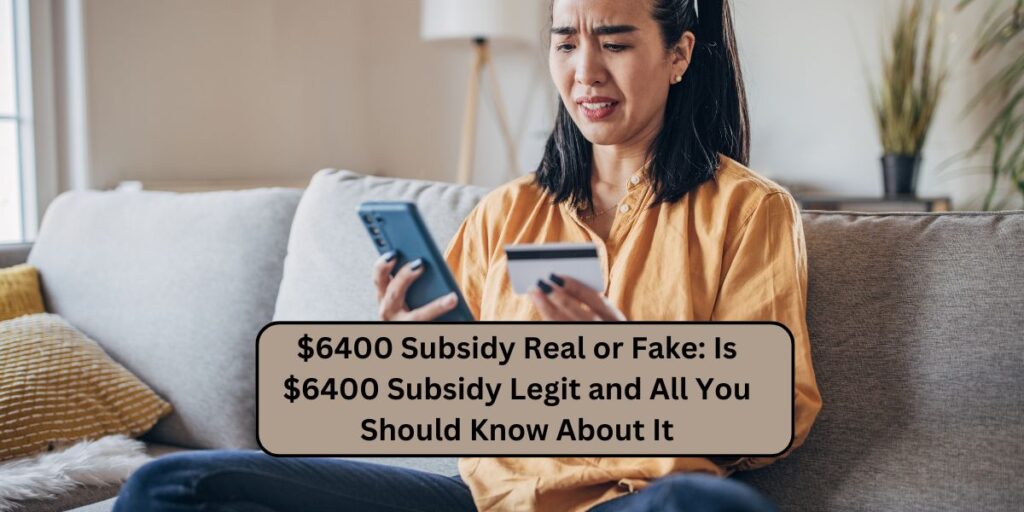Explore the information about the $6400 Subsidy: Legitimacy, Facts, and Everything You Need to Know in this article. It covers details on whether the $6400 Subsidy is real or fake, along with other pertinent information.
$6400 Subsidy Real or Fake
There is currently a new scam circulating in the United States involving a purported free $6400 subsidy. Pop-ups and advertisements promoting this subsidy feature images of Joe Biden and Snoop Dogg to create an appearance of legitimacy.
Despite its convincing appearance, the $6400 subsidy is fraudulent and poses a risk of draining citizens’ accounts. This scam specifically targets senior citizens relying on Social Security benefits.
Is $6400 Subsidy Legit?
The $6400 subsidy is completely illegitimate. If you encounter an advertisement offering free money or a subsidy, avoid clicking on it altogether. These ads are designed to appear authentic and trustworthy but are actually part of a scam aimed at defrauding innocent citizens of their money.
When someone clicks on the $6400 subsidy advertisement or pop-up, they are prompted to enter their personal information to determine eligibility. In the pursuit of obtaining free money, individuals frequently divulge crucial details such as bank information and other personal data.
Scammers exploit this information to steal money or identities, often targeting senior citizens enrolled in social security programs because they believe seniors may be less familiar with protecting themselves from scams.
Clicking on these scam advertisements connects individuals with scammers, not with the government. Scammers impersonate well-known figures like politicians, musicians, or journalists to appear credible, tricking people into falling for their schemes.
It’s crucial for everyone to report these scams whenever they encounter them. Reporting can safeguard individuals and prevent others from becoming victims of fraud.
When a scam is reported, authorities investigate to determine its legitimacy. If confirmed as fraudulent, they will take action to shut down the website or advertisements and prosecute the scammers rigorously.
For individuals unsure how to handle seemingly legitimate scams, it’s crucial to report them promptly to the authorities. These scams often entice people with promises of substantial sums of money and benefits to trick them into sharing personal information.
All You Should Know About $6400 Subsidy
In March, a fraudulent scheme surfaced featuring Snoop Dogg and Joe Biden promising a $6400 subsidy. The fake advertisements claimed that Biden and Snoop Dogg had collaborated to offer this subsidy to Social Security recipients.
These deceptive pop-ups and ads predominantly appeared on TikTok, targeting senior citizens to steal their sensitive personal information. The scam falsely asserted that the United States government was distributing a $6400 payment, promising recipients they could receive the funds within 48 hours.
The scammers orchestrated this scheme to deceive people into believing it was a legitimate government initiative. However, it was designed solely to extract personal information and money from unsuspecting individuals.
How to Avoid Scams?
If you come across advertisements or pop-ups promising free money, it’s important to report them immediately. Avoid clicking on any links included in these ads, as they may contain harmful viruses or scripts used by scammers to steal personal information.
To report such scams, you can visit the official website of the Federal Trade Commission (FTC). The FTC shares these reports with more than 2,800 law enforcement agencies to expedite resolution.
These reports aid in further investigations and help build cases against fraudulent activities and scams. They are not limited to scams alone but also cover fraudulent practices and unethical business activities.
It’s important to report suspicious activities even if unsure whether they are fraudulent. Reporting can significantly assist law enforcement in identifying potential scams and unethical business practices.
Additionally, raising awareness about these scams among friends and family is crucial for their protection. The purported $6400 free subsidy is indeed fake, as the government does not offer such benefits.
For accurate information on available government aid and benefit programs, individuals can visit authorized websites like benefits.gov, govloans.gov, and grants.gov.

